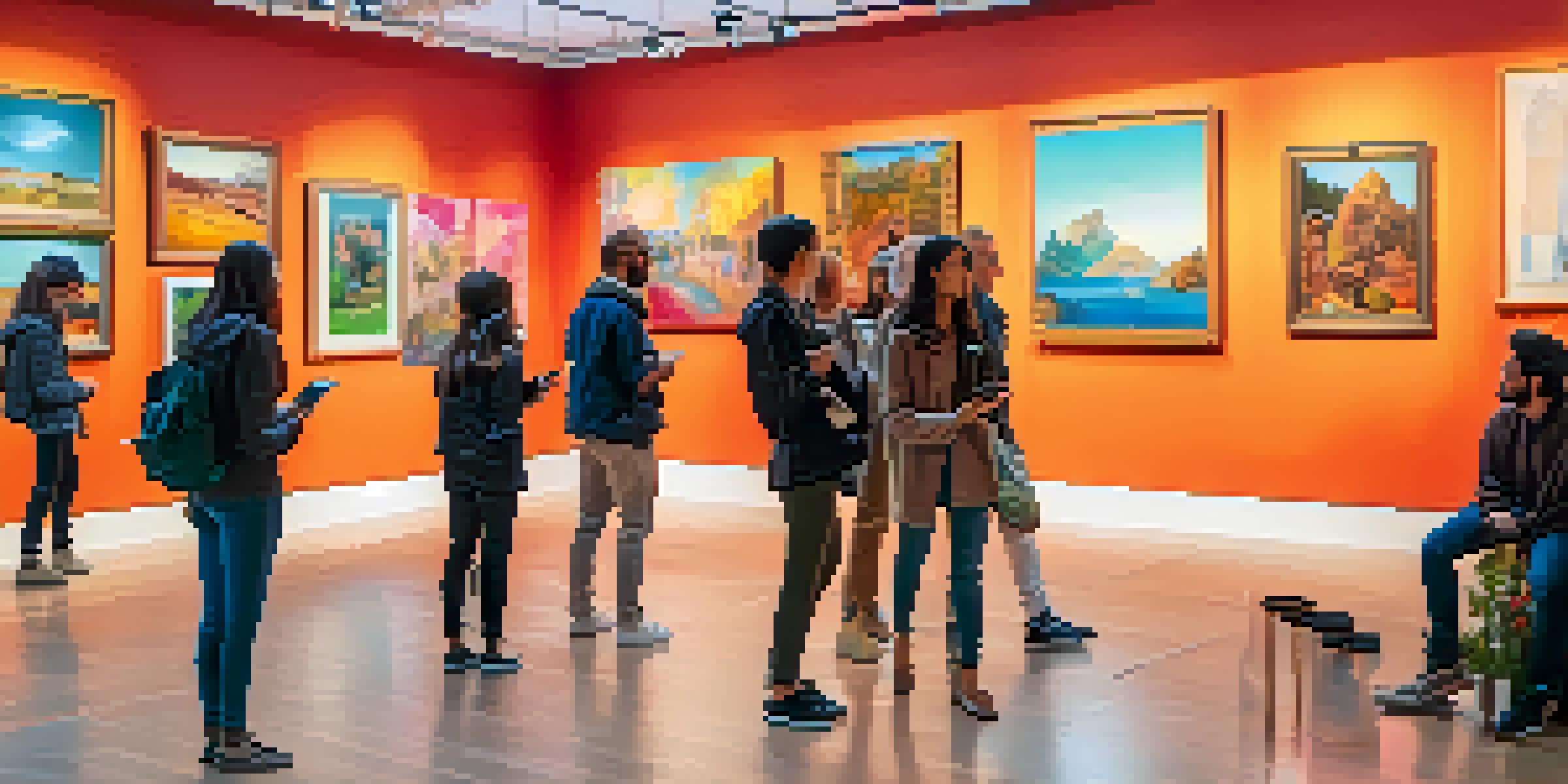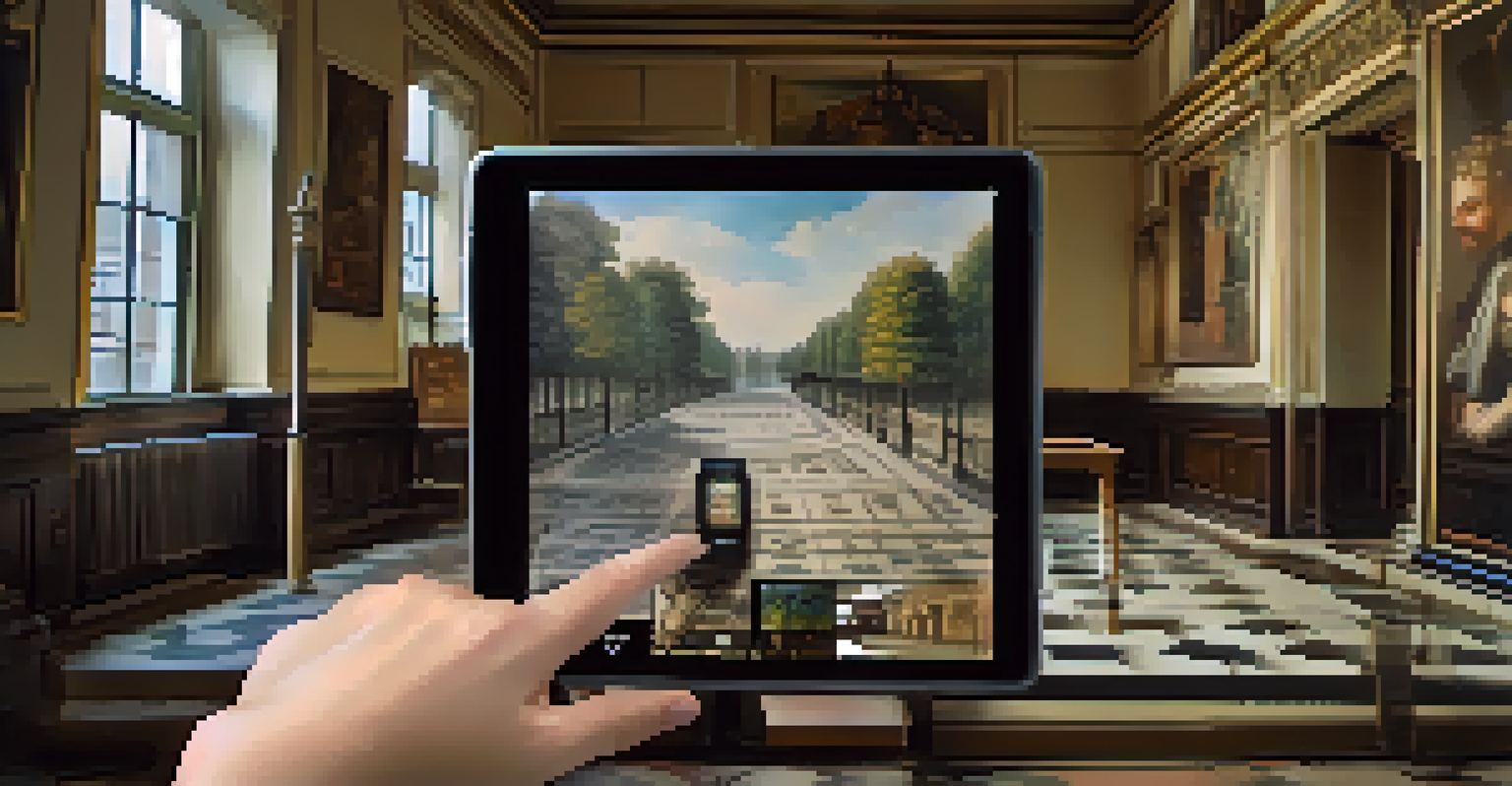Augmented Reality: Enhancing the Viewing of Paintings

Understanding Augmented Reality in Art
Augmented Reality (AR) is a technology that superimposes digital information onto the real world. Imagine standing in front of a painting and watching it come to life with animations and sounds. This innovative approach enhances our experience, allowing us to engage with the artwork beyond its physical form.
Art is not freedom from discipline, but disciplined freedom.
In the context of art, AR can provide historical context, artist insights, and even interactive features. For example, a classic painting could reveal the artist's techniques or the story behind the piece as you view it. This makes art more accessible and engaging, especially for younger audiences or those unfamiliar with art history.
Ultimately, AR bridges the gap between art and technology, creating a richer experience for viewers. By integrating visual and auditory elements, AR invites us to explore paintings in ways we never thought possible, transforming passive observation into active participation.
The Benefits of AR in Art Galleries
Art galleries are embracing AR to enhance visitor experiences and attract more audiences. With AR apps, visitors can use their smartphones or tablets to access additional content related to the artworks on display. This added layer of information enriches their understanding and appreciation of the pieces.

Moreover, AR can help create a more immersive environment. Picture walking through a gallery where each artwork tells a story through animations or virtual tours. This not only captivates visitors but also encourages them to spend more time engaging with the exhibits.
AR Enhances Art Engagement
Augmented Reality transforms passive observation into active participation, making art more accessible and engaging.
Additionally, AR can cater to diverse audience needs, offering translations, audio guides, and interactive activities. This inclusivity ensures that everyone, regardless of their background or level of art knowledge, can connect with the artwork in a meaningful way.
AR and Educational Experiences in Art
AR is an incredible tool for education, especially in teaching art history and appreciation. Imagine students learning about Impressionism while standing in front of a Monet, with an AR app showing how the painting was created. This hands-on learning experience helps them grasp complex concepts in a fun and engaging manner.
The best way to predict the future is to create it.
By incorporating AR into educational programs, institutions can foster a deeper connection between students and art. Interactive features can spark discussions, encouraging critical thinking and analysis of artistic styles and intentions. This not only makes learning enjoyable but also memorable.
Furthermore, AR can help bring art into the classroom, making it accessible to those who may not have the opportunity to visit galleries. With just a smartphone, students can explore famous artworks and gain insights that expand their horizons beyond textbooks.
Examples of Successful AR Art Projects
Several art institutions have already begun to harness the power of AR. For instance, the Van Gogh Museum in Amsterdam launched an AR app that allows visitors to see Van Gogh's paintings alongside his sketches and letters. This contextual information provides deeper insight into the artist's thought process and creativity.
Another notable example is the 'Artivive' app, which has been used in various exhibitions worldwide. It allows artists to add a digital layer to their physical artworks, creating an interactive experience that captivates audiences. Users can scan the artwork and watch it transform, bringing a new dimension to traditional art forms.
AR in Education Boosts Learning
AR provides immersive educational experiences, allowing students to learn about art history in an interactive and memorable way.
These projects illustrate how AR can breathe new life into art and foster a greater appreciation for creativity. By showcasing innovative applications, they set a precedent for future endeavors in the art world.
The Role of Artists in AR Integration
As AR technology evolves, artists are adapting their creative processes to incorporate it. Many artists now consider how their work can interact with digital elements, blurring the lines between traditional and digital art. This collaboration opens doors to new forms of expression and storytelling.
Moreover, artists can use AR to reach wider audiences. By integrating technology into their work, they can engage viewers in different environments, from galleries to public spaces. This accessibility allows art to transcend physical limitations and reach people in innovative ways.
Ultimately, artists play a crucial role in shaping the future of AR in art. Their creativity and willingness to experiment with new mediums will continue to push boundaries and inspire future generations of art enthusiasts.
Challenges of Implementing AR in Art
Despite its potential, integrating AR into the art world is not without challenges. One significant hurdle is the cost of developing AR applications and ensuring they function smoothly in various environments. This can deter smaller galleries or independent artists from exploring this technology.
Additionally, there may be resistance from traditionalists who believe that AR detracts from the authenticity of the art experience. They may argue that art should be appreciated in its original form without digital interference. Balancing innovation with tradition is a delicate task for the art community.
Challenges of AR Integration
Despite its potential, implementing AR faces challenges such as costs, resistance from traditionalists, and accessibility issues.
Lastly, there's the issue of accessibility. Not everyone has access to smartphones or the internet, which can limit the reach of AR experiences. Ensuring that AR applications are inclusive and reachable for all audiences is vital for their successful implementation.
The Future of AR in the Art World
Looking ahead, the future of AR in the art world appears promising. As technology continues to advance, we can expect even more innovative ways to engage with art. Imagine virtual reality experiences combined with AR, allowing viewers to step inside a painting and explore its world.
Moreover, as more artists and institutions adopt AR, it will become increasingly mainstream. This can lead to collaborations between tech companies and artists, resulting in groundbreaking projects that redefine the boundaries of art. The fusion of creativity and technology will undoubtedly shape the next generation of art experiences.

Ultimately, AR has the potential to revolutionize how we interact with art, making it more engaging and accessible. By fostering a deeper connection between audiences and artworks, AR will ensure that the appreciation of art continues to thrive in our technology-driven world.